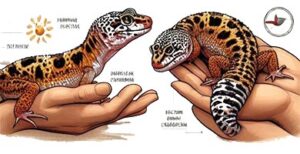Leopard geckos are generally hardy reptiles when provided with proper care, but they can still be susceptible to various health issues. Here are some common diseases and health concerns that leopard gecko owners should be aware of:
1. Parasitic Infections:
Parasites such as coccidia, pinworms, and mites can affect leopard geckos. Symptoms may include diarrhea, weight loss, lethargy, and visible parasites in feces or on the skin. Regular fecal examinations by a reptile veterinarian and proper hygiene practices can help prevent parasitic infections.
2. Respiratory Infections:
Respiratory infections can occur due to poor husbandry practices, such as inadequate temperature or humidity levels, or exposure to drafts. Symptoms may include wheezing, nasal discharge, open-mouth breathing, and lethargy. Prompt veterinary treatment with appropriate antibiotics is necessary to resolve respiratory infections.
3. Metabolic Bone Disease (MBD):
MBD is a common condition in reptiles, including leopard geckos, caused by calcium deficiency, improper UVB lighting, or inadequate supplementation. Symptoms may include tremors, weakness, softening of the bones, swollen joints, and difficulty walking. Prevention involves providing proper UVB lighting, calcium supplementation, and a balanced diet.
4. Dysecdysis (Abnormal Shedding):
Dysecdysis occurs when a leopard gecko has difficulty shedding its skin properly. This can be caused by low humidity, inadequate hydration, or underlying health issues. Signs of dysecdysis include retained shed, stuck shed on toes or tail, and irritation or inflammation of the skin. Providing a humid hide and ensuring proper hydration can help prevent dysecdysis.
5. Impaction:
Impaction occurs when a leopard gecko ingests substrate or foreign objects, leading to blockages in the digestive tract. Loose substrates like sand or gravel pose a higher risk of impaction. Symptoms may include constipation, bloating, loss of appetite, and lethargy. Providing a substrate-free enclosure or using safe substrate alternatives can help prevent impaction.
6. Tail Loss (Autotomy):
Leopard geckos have the ability to drop their tails as a defense mechanism (autotomy). While tail loss itself is not a disease, it can lead to stress, infection, or injury if not properly cared for. Keep the wound clean and monitor for signs of infection, such as redness, swelling, or discharge.
7. Eye Infections:
Eye infections can occur due to bacterial or fungal pathogens, injuries, or foreign objects irritating the eyes. Symptoms may include redness, swelling, discharge, and difficulty keeping the eyes open. Prompt veterinary treatment with appropriate medications is necessary to treat eye infections and prevent complications.
8. Overgrown Nails or Teeth:
Overgrown nails or teeth can occur if a leopard gecko’s claws or teeth are not worn down naturally. Long nails can lead to difficulty walking or substrate impaction, while overgrown teeth can cause difficulty eating or oral injuries. Regular nail trimming and providing appropriate surfaces for nail and teeth maintenance can help prevent overgrowth.
Regular health checks, proper husbandry practices, and prompt veterinary care are essential for preventing and managing common diseases and health issues in leopard geckos. If you notice any signs of illness or abnormalities in your gecko, consult with a reptile veterinarian for diagnosis and treatment.



